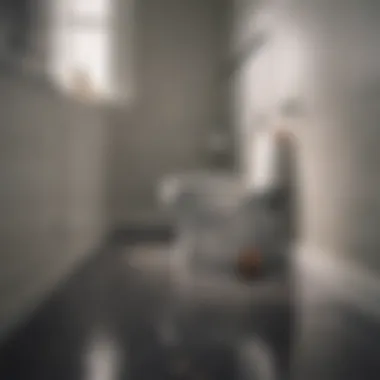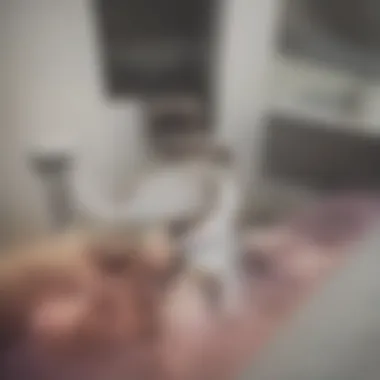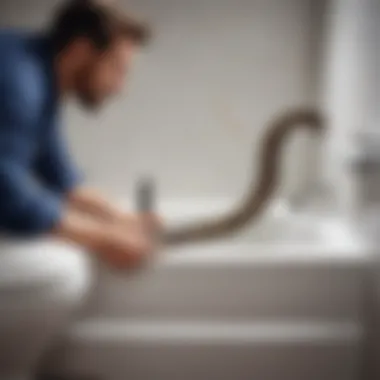Clogged Toilets and Bathtubs: Causes and Solutions


Intro
Clogged toilets and bathtubs present a significant challenge in household maintenance. As everyday occurrences, they often lead to inconveniences if not addressed swiftly. Understanding the reasons behind these clogs and knowing how to approach their resolution is crucial for homeowners. This guide aims to equip you with relevant strategies to handle such plumbing issues effectively.
By delving into the mechanics behind plumbing systems, we will identify common causes of clogs, present practical solutions for unclogging, and discuss preventive measures to minimize future incidents. Homeowners have the power to restore their bathrooms' functionality with informed decision-making.
The implications of engaging with this material are significant. Enhanced knowledge translates to better home management, allowing homeowners to navigate plumbing concerns with confidence. Understanding these challenges can lead to improved household efficiency and a more enjoyable living environment.
Understanding Toilet and Bathtub Plumbing Systems
Understanding the plumbing systems of toilets and bathtubs is foundational for tackling clogged fixtures effectively. Knowing how these systems function can help homeowners identify problems early and apply appropriate solutions. A solid grasp of plumbing dynamics benefits not only in maintenance but also in enhancing overall home efficiency.
Plumbing Basics
At the heart of any plumbing system are the principles of water flow and waste disposal. Toilets and bathtubs are designed to carry waste and water away from the home effectively. The system comprises several interconnected pipes, valves, and fixtures. Each component plays a crucial role in ensuring that the plumbing functions smoothly.
Water enters the toilet or bathtub via supply lines and is directed through controlled mechanisms. In toilets, for instance, the flush mechanism initiates a powerful flow, efficiently moving waste through the drain pipe. Bathtubs typically employ overflow drain systems, preventing spills by allowing water to escape once levels reach a designated point. Understanding these processes can allow homeowners to intervene before minor issues escalate into major clogs.
Common Components of Toilet and Bathtub Systems
The plumbing system in toilets and bathtubs consists of various components that work in harmony. Recognizing these parts is essential for diagnosing issues correctly. Common elements include:
- Supply Lines: These are pipes that bring freshwater into fixtures. Proper inspection of supply lines is critical to avoid leaks.
- Drain Pipes: These pipes carry waste to the sewer system. Clogs are common here, and understanding their layout can help in quick resolutions.
- Traps: Found in both toilets and bathtubs, traps hold water to prevent sewer gases from entering the home. If they become blocked, this can lead to unpleasant odors.
- Valves: These control the flow of water to fixtures. Leaky or defective valves can contribute to problems that lead to clogs.
By familiarizing oneself with these components, homeowners can better understand where the potential issues might arise and how to address them effectively.
Identifying Causes of Clogs
Understanding the causes of clogged toilets and bathtubs is essential for homeowners. By identifying the sources of these clogs, individuals can take proactive measures to mitigate the issue before it becomes severe. The significance of recognizing these causes lies in preventing the disruptions that clogs can bring to daily life. Not only do clogs affect functionality, but they can also lead to costly repairs if left unchecked. By diagnosing the specific elements causing the obstruction, homeowners can implement targeted solutions and enhance their overall home management.
Toilet Clogs: Common Sources
Toilets can become clogged for varied reasons. One prevalent source is excessive toilet paper usage. Many people do not realize that their toilets cannot handle large amounts of paper at once. Another issue arises from flushing inappropriate items. Items like feminine hygiene products, baby wipes, or even excessive amounts of facial tissues can contribute to serious blockages.
Additionally, build-up can occur over time due to mineral deposits from hard water. These deposits can make it harder for water to flow through the pipes, leading to blockages. Toilets that are old or poorly designed may also contribute to this problem, as their flushing mechanisms may be less efficient compared to modern standards.
Bathtub Clogs: Understanding the Factors
Bathtub clogs often stem from different origin points compared to toilets. Hair is the primary culprit here. Over time, hair can gather and form significant clogs within the drain. This is especially common in households with multiple family members, where hair loss is more prevalent.
Soap scum is another significant factor. Many soaps and shampoos contain ingredients that can create a residue which can line the pipes, trapping debris and leading to slow drains and clogs. Additionally, foreign objects accidentally dropped into the tub can lead to unexpected blockages.
Understanding these specific causes helps homeowners take necessary actions to reduce the risk of clogs. Regular maintenance and being mindful of what goes down the drains can alleviate many potential problems.
Consequences of Clogged Toilets and Bathtubs
Understanding the consequences of clogged toilets and bathtubs is crucial for every homeowner. When these fixtures become obstructed, they cause more than just inconveniences. The impacts can extend into various aspects of daily life, affecting functionality and overall well-being.


Impact on Household Functionality
Clogs can disrupt normal household routines. A blocked toilet can halt use in a single bathroom, affecting multiple family members. In homes with more than one bathroom, the issue may be slightly alleviated, but overall comfort is diminished. Moreover, a clogged bathtub can prevent individuals from performing essential hygiene routines. This leads to frustrations and can disrupt schedules, especially for those who require timely access to these facilities.
"Clogged toilets not only create discomfort but cost time and resources, leading to potential long-term damage if neglected."
The impact is not just limited to inconvenience. It may also lead to increased utility bills. Blockages may require excessive use of water to force a clog through pipes or, in some instances, a complete overhaul of plumbing systems. Homeowners may need to consider the potential of damaged plumbing connections, which can escalate into costly repairs.
Health Risks Associated with Clogs
Ignoring a clog can pose serious health risks. Waste can back up, creating unsanitary conditions that promote harmful bacteria and mold. Such environments can influence the air quality in the home and may result in respiratory issues or other health complications for those exposed to unsanitary conditions.
Additionally, lingering water in bathtubs can become a breeding ground for insects. Mosquitos and other pests thrive in stagnant water, potentially introducing new health issues. Health risks extend beyond the individual family members to pets as well, which may be affected by the unsanitary water or surfaces.
In summary, the consequences of ignoring clogged toilets and bathtubs stretch far beyond the immediate inconvenience. From disrupted daily life to serious health implications, being aware of these consequences can motivate homeowners to take preventive measures and address clogs promptly. This understanding is essential for maintaining a comfortable and healthy living environment.
Effective Methods for Clearing Clogs
Addressing clogged toilets and bathtubs is crucial for maintaining a functional home. The inability to efficiently clear a clog can lead to bigger plumbing issues and inconvenience. Deploying effective methods for clearing clogs not only rectifies the immediate problem but also enhances overall household efficiency. With proper techniques and tools, homeowners can tackle clogs with confidence.
Manual Tools and Techniques
When it comes to unclogging toilets and bathtubs, manual methods present a reliable first line of defense. Such methods can often resolve simple to moderate clogs without the need for chemical interventions.
- Plunger: This common tool remains the go-to solution. A toilet plunger has a cup-shaped rubber end, designed to create strong suction. When using a plunger:
- Drain Snake: A drain snake, also known as an auger, is useful for deeper clogs. Feed the snake into the drain until resistance is felt, then twist and push to break the clog apart or pull it out.
- Wet/Dry Vacuum: This tool can remove clogs as well, particularly in bathtubs. Set it to liquid mode and create a tight seal around the drain. Turn it on, and the vacuum can often pull out the blockage.
- Ensure there's enough water in the bowl or tub.
- Position the plunger over the drain.
- Push down gently and then pull up quickly. Repeat until the water drains.
Each method has its benefits. Manual tools are immediate and often economical. They don’t rely on chemicals, making them a safer choice for household members and pets.
Chemical Solutions: When to Use Them
While manual tools serve as effective measures, sometimes creative clogs require chemical solutions. Chemicals can dissolve certain blockages, but caution is advised regarding their application and potential consequences.
- Drain Cleaners: Commercial drain cleaners contain powerful ingredients that break down clog material. However, they can be harsh on plumbing and potentially harmful if misused. Check the guidelines on the product label. Use sparingly, and avoid combining with other cleaners.
- Baking Soda and Vinegar: An eco-friendly alternative involves a combination of baking soda and vinegar. Pour half a cup of baking soda into the drain, followed by half a cup of vinegar. Wait for about 30 minutes, then flush with hot water. This reaction effectively dislodges some clogs but may not work on more stubborn blockages.
- Boiling Water: For minor clogs, pouring boiling water down the drain may dissolve soap scum or grease. This method is safe for many plumbing systems but should be avoided with PVC pipes that can warp.
In summary, using chemical solutions should be done judiciously. Always prioritize safety for both users and plumbing systems. It’s valuable to understand the nature of the clog before selecting any method to ensure effectiveness and reduce risk.
Remember: Not every clog requires drastic measures. Assessing the situation is key to choosing the right approach.
Discerning When to Call a Professional
Addressing the issue of clogged toilets and bathtubs can often begin as a straightforward task for homeowners. However, there are instances when amateur attempts to resolve these issues may not only fail but could also exacerbate the situation. Knowing when to call a professional plumber is crucial. By understanding the complexity of plumbing systems and the potential consequences of improperly handled clogs, homeowners can save time, avoid costly damages, and ensure that their plumbing remains in good order.
Signs Indicating Professional Assistance is Required
Homeowners should remain vigilant to signs that indicate a clog has moved beyond their capabilities to fix. Key indicators include:


- Multiple fixtures clogged at the same time: If both the toilet and bathtub are backing up, the issue could be deeper within the plumbing.
- Persistent odors: Lingering foul smells may signal a severe blockage or a sewer issue, which needs professional diagnostics.
- Slow drainage: Gradual drainage issues that worsen over time can point to deeper plumbing blockages that a homeowner cannot clear with standard tools.
- Frequent need for unclogging: If a specific drain requires frequent attention, then the underlying problem may need a specialized approach that only a professional can provide.
- Overflowing toilets or bathtubs: Situations where water threatens to overflow can lead to significant damage if not addressed by an expert.
Each of these signs can indicate that a small problem has escalated into a much larger one. Ignoring these signs can lead to severe plumbing disasters, which can be costly to fix.
Cost Considerations for Professional Help
When the decision to call a professional plumber arises, homeowners often wonder about the potential costs involved. While hiring an expert is undoubtedly more expensive than DIY solutions, it is essential to consider the benefits it offers.
- Diagnostic Fees: Many plumbers charge a fee for diagnostics, which is generally applied to the overall service cost if repairs are performed.
- Hourly Rates: Plumbers may charge based on time. Rates vary widely depending on geographical location and the plumber’s experience.
- Replacement Costs: In certain situations, clogged pipes may necessitate replacement rather than repair, leading to higher expenses.
- Emergency Services: After-hours service calls frequently incur higher fees. However, tackling a critical issue during an emergency can prevent more severe damage down the line.
Investing in professional assistance often leads to better solutions, saving time and potentially preventing more significant costs later on. The upfront cost of hiring an expert should be weighed against potential long-term benefits for the plumbing system.
"In the realm of plumbing, hesitation can lead to chaos. Knowing when to call a professional is crucial in preserving both functionality and financial stability."
Whether it is for complex issues or severe emergencies, recognizing these signs and understanding the associated costs can empower homeowners to make informed decisions about their plumbing needs.
Preventive Measures to Avoid Clogs
Preventive measures are essential in maintaining smooth plumbing systems in homes. Understanding how to avoid clogs can save homeowners time, money, and stress. It is much easier to prevent issues than to rectify them once they occur. Taking proactive measures helps maintain the integrity of the plumbing system, ensuring consistent functionality and reducing the risks associated with significant blockages.
Regular Maintenance Practices for Toilets and Bathtubs
Regular maintenance is key to avoiding clogs in toilets and bathtubs. Following some simple routines can drastically reduce the likelihood of encountering plumbing problems.
- Cleaning: Regularly clean toilet bowls and bathtubs using appropriate cleaners. This can help eliminate buildup of soap scum and mineral deposits, which often contribute to clogs.
- Flushing: Do not flush items other than human waste and toilet paper. Flushing sanitary products, wipes, or excessive amounts of paper can easily cause blockages.
- Drain Cleaning: Employ a monthly drain cleaning practice. Using a mixture of vinegar and baking soda can help break down minor build-up in pipes, keeping them clear.
- Visual Inspections: Check for slow draining situations. If there is a noticeable change in drainage speed, investigate immediately to prevent bigger issues later.
Implementing these practices can significantly enhance the longevity of plumbing systems. Homeowners should not overlook the importance of these small, yet effective tasks.
Educating Household Members on Proper Usage
Educating all members of the household about the proper use of toilets and bathtubs is another vital aspect. Everyone should be aware of what is acceptable to flush and what is not. This knowledge can be the difference between a smoothly functioning system and a troublesome clog.
- Communication: Discuss the plumbing rules with all residents, emphasizing the importance of not flushing inappropriate items down the toilet.
- Signage: Consider placing reminders near toilets and bathtubs about what should and should not be flushed or washed down the drain. This is especially useful in homes with children.
- Using Devices Appropriately: Make sure everyone understands the functionality of toilets and bathtubs, including the importance of using them properly to avoid excess strain which can lead to issues.
Effective education of household members not only prevents clogs, but also fosters a collective responsibility towards maintaining the home.
Innovations in Plumbing Technology
The field of plumbing technology has seen a remarkable evolution in recent years. As household needs grow and environmental imperatives change, innovative solutions are necessary. Understanding these advancements can significantly improve home efficiencies, particularly when it comes to preventing and addressing clogs in toilets and bathtubs. This section focuses on two noteworthy innovations: smart toilets and advanced bathtub designs. Each of these implementations not only helps minimize clogs but also offers associated benefits that enhance overall user experience.
Smart Toilets and Their Impact
Smart toilets represent a fusion of modern technology and traditional plumbing. These toilets often include features such as self-cleaning mechanisms, automatic flushing, and even bidet functionalities. One major impact of smart toilets is their ability to minimize clogs. They often come equipped with sensors that optimize water usage based on need, ensuring that excess waste is washed away efficiently.
Moreover, some smart toilets can diagnose issues by alerting homeowners to irregular water usage patterns. For example, if the toilet fails to flush properly, it can send a notification, prompting immediate attention before the situation worsens. This proactive approach can lead to significant savings on plumbing repairs in the long run.
"Smart plumbing devices not only solve current problems but also anticipate future issues, guiding homeowners toward preventive actions."


In addition, smart toilets tend to be designed with high-efficiency systems. This allows for adequate flushing power while using less water, aligning with sustainability goals. Their ease of integration into existing systems represents an attractive option for modern homes.
Advanced Bathtub Designs to Minimize Clogs
Bathtub technology has also progressed to include designs that actively work to combat clogs. Advanced bathtubs often feature improved drainage systems and self-cleaning capabilities. These designs focus on preventing hair and soap buildup, which are common culprits in bathtub clogs. For instance, some bathtubs use special materials that repel soap scum and make cleaning easier.
Another noteworthy feature is the incorporation of larger drainage openings. This simple design adjustment can significantly reduce the frequency of clogs caused by slow drainage. Additionally, many modern bathtubs now integrate features like adjustable overflow drains that maintain optimal water levels without risking overflows – which, in turn, supports the home's overall plumbing health.
These advances in bathtub design underscore the importance of not just reactive measures to clogs, but also preventive strategies. By investing in smart plumbing technologies, homeowners can reduce maintenance hassle while enhancing the overall efficiency of their bathing experience.
In summary, plumbing technology innovations present a transformative opportunity for homeowners. By considering these advancements, they can make informed decisions that lead to lower incidences of clogs and a more satisfying home experience.
Environmental Considerations
The increasing awareness of environmental issues highlights the necessity of addressing clogged toilets and bathtubs with a clear focus on sustainability. The plumbing industry has faced criticism for its impact on the environment through excessive water usage and reliance on harmful chemicals for cleaning. Hence, understanding and implementing eco-friendly solutions should be a priority for homeowners. Sustainable plumbing practices not only contribute to the conservation of water resources but also promote better water quality and reduce pollution levels in the surrounding area.
Eco-Friendly Solutions for Clog Removal
When traditional methods of unclogging toilets and bathtubs prove ineffective, homeowners often turn to heavy-duty chemical cleaners. However, many of these products come with toxic ingredients that pose risks to both health and the environment.
Here are some effective eco-friendly alternatives:
- Baking Soda and Vinegar: This natural combination can break down clogs. Pour a cup of baking soda followed by a cup of vinegar into the drain. Allow it to fizz for about thirty minutes before flushing it with hot water.
- Hot Water Flushes: Sometimes, simply pouring hot water down the drain helps dissolve minor blockages. This method is simple and requires no chemicals.
- Use of a Plumber's Snake: A plumber's snake is a manual tool that allows you to physically remove clogs without the need for chemicals. This method is particularly effective for stubborn blockages deep within the pipes.
Implementing these methods ensures that we reduce our environmental footprint while effectively tackling clogs.
The Importance of Sustainable Plumbing Practices
Sustainable plumbing practices go beyond simply removing clogs; they involve the installation and maintenance of systems that prioritize environmental health. It includes the use of low-flow fixtures, which significantly reduce water usage without sacrificing performance. Many modern toilets, such as those from Kohler or American Standard, use advanced technology to minimize the volume of water required per flush, saving thousands of gallons over time.
Additionally, using water-resistant materials and efficient insulation in plumbing systems can prevent leaks and conserve energy. This not only optimizes the plumbing system but also reduces long-term costs for homeowners. Choosing these sustainable options is a responsible choice that can lead to healthier homes and ecosystems.
Moreover, raising awareness among family members about the importance of these practices can foster a culture of sustainability at home. By taking small, conscientious steps, individuals can contribute to a larger movement towards environmental preservation.
Culmination: The Importance of Awareness
Awareness is essential when dealing with clogged toilets and bathtubs. This problem is common, yet many homeowners do not fully understand the implications of neglecting such issues. A clogged toilet or bathtub can disrupt daily routines and lead to bigger plumbing woes. Understanding the underlying causes and effective solutions can empower homeowners to take the right actions before a minor issue becomes a major inconvenience.
Additionally, being aware of preventive measures can save time, money, and frustration in the long run. Regular maintenance and knowledge about proper use are crucial elements that can help maintain a functional plumbing system. By fostering awareness, homeowners can not only deal with current challenges but also mitigate future risks.
"Awareness is the first step toward effective home management."
Summarizing Key Takeaways
- Understanding Causes: Recognizing the common causes of clogs, such as hair, soap residue, and foreign objects, is vital. Homeowners can often prevent these issues through simple habits.
- Effective Solutions: Knowing how to tackle a clog with tools or methods can speed up the resolution. For many, using a plunger or a plumbing snake can be effective first steps.
- Professional Help: Understand when to seek professional assistance. Delaying a call can lead to more significant damage and costly repairs.
- Prevention: Regular maintenance, such as cleaning drains and educating household members on proper use, is key to preventing clogs.
Encouraging Proactive Home Maintenance
Proactive home maintenance should be a priority for every homeowner. Here are several strategies to maintain plumbing systems effectively:
- Regular Inspections: Performing routine inspections of toilets and bathtubs can help spot potential problems before they worsen.
- Use Strainers: Installing strainers in bathtubs can catch hair and soap scum before they lead to clogs.
- Proper Disposal: Educating all household members about proper disposal of items can prevent foreign objects from entering the plumbing system.
- Scheduled Cleaning: Develop a regular cleaning schedule for drains using natural or eco-friendly solutions. This can help ensure that buildup does not become an issue.
- Document Maintenance Activities: Keeping a log of maintenance activities can help track what has been done and when to plan next follow-ups.
In summary, awareness and proactive measures are fundamental in effectively managing clogged toilets and bathtubs. By being informed and prepared, homeowners can enjoy a smoother and more efficient plumbing experience.







